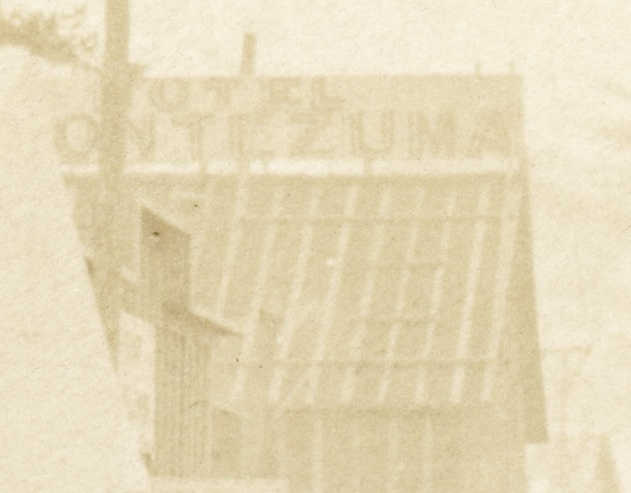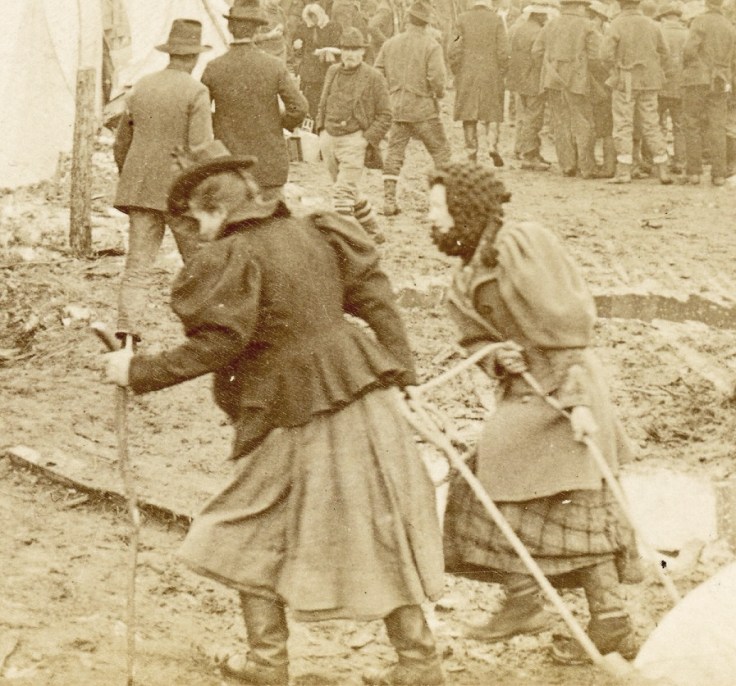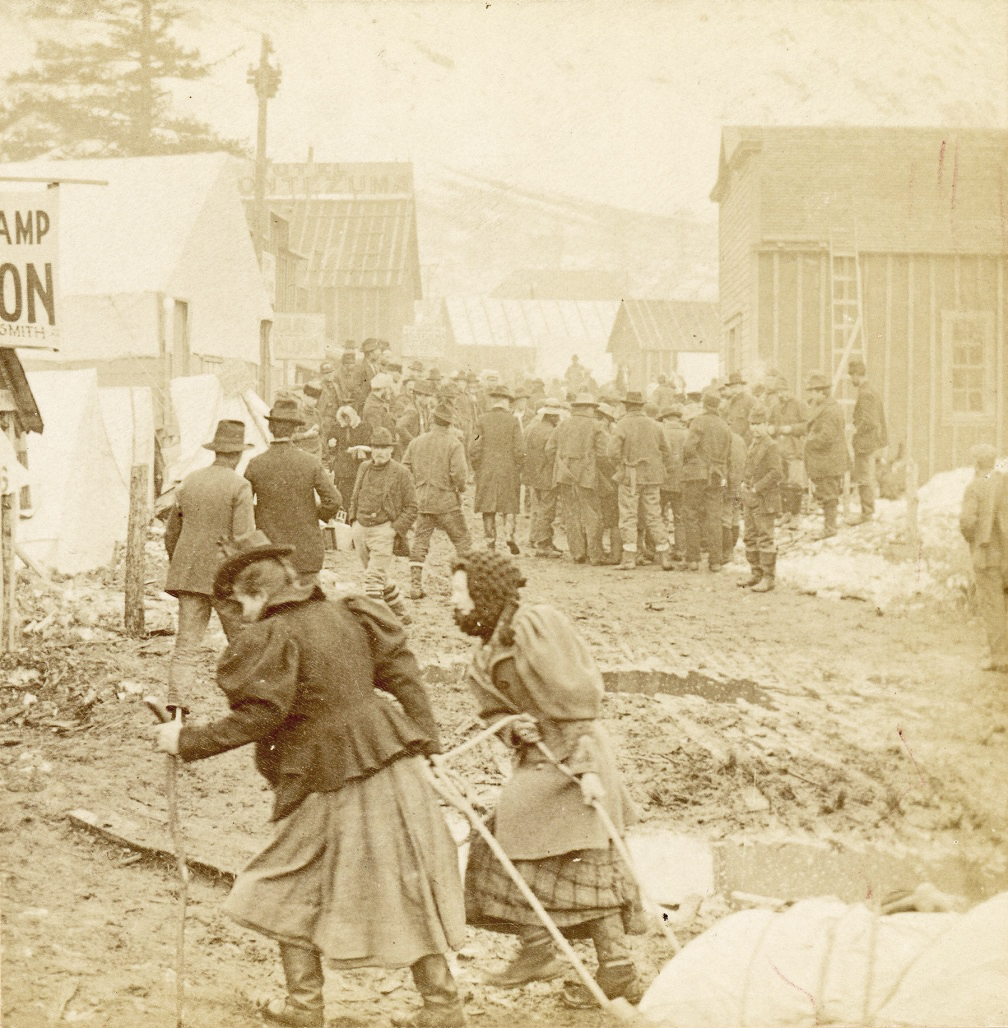The image above is the right half of a stereograph (stereoview) published by Benjamin West Kilburn and James M. Davis in 1898.


The Klondike Gold Rush began in 1896 and lasted until 1899, with many fortune hunters arriving in the summer of 1898. Canadian authorities required all prospectors to bring a year’s supply of food, weighing nearly a ton, which had to be hauled over the grueling Chilkoot Pass from Dyea, Alaska. According to YukonInfo.com, the average Klondiker had to make forty trips over the Pass to haul the entire load, amounting to 2,600 miles on foot (4,200 km).
The location of the photo isn’t specified, but in the distance is a sign for the Hotel Montezuma, which was in Dawson City, Yukon Territory. (I found only one reference to the hotel online, in a guide to the Vernon Humble Collection of photographs at the Anchorage Museum at Rasmuson Center in Anchorage, Alaska.)

My favorite detail might be the homemade walking stick in the hand of the woman on the left:

Dawson City is much easier to get to today–and less muddy–but still very remote. I found a wonderful photo essay about the town in GQ magazine, published in August 2017. I highly recommend you take a look.











They must have had astonishingly strong constitutions to deal with all that. I wonder if people these days would manage it? Fabulous photo(s), Brad. And I had a look at the article – my ‘net connections a bit too glitchy to see it all (very stormy here at the moment) but shall try again later.
LikeLiked by 2 people
Thank you, Val. I hope the storm passes by without incident.
LikeLiked by 2 people
I hope so too, thanks. It seems to be calming down.
LikeLiked by 2 people
The knit hood with bobbles!
LikeLiked by 2 people
Yes, yes! Bobbles are important….
LikeLiked by 1 person
Do you think they were actually prospectors or was the photo a set up? Either way I don’t envy any of the people in that mud hole!
LikeLiked by 1 person
I gave that a lot of thought, Shayne, when I was putting together the post. I wondered, “Am I asking that just because they’re women? Would I ask it if they were men? Is that male bias, or is it a reasonable question, based on the fact that the photo was produced for sale?” I decided that it’s a reasonable question, but that I believe they are actual prospectors, or at least members of a team that might have included men. The photo doesn’t look posed to me, the way so many were in those days.
There are several books on the subject, including:
“Two Women in the Klondike,” by Mary E. Hitchcock
“Wealth Woman: Kate Carmack and the Klondike Race for Gold,” by Deb Vanasse
“Frontier Spirit: The Brave Women of the Klondike,” by Jennifer Duncan
“Klondike Women: True Tales of the 1897-1898 Gold Rush,” by Melanie J. Mayer
“Women of the Klondike,” by Frances Backhouse
LikeLiked by 2 people
Sounds like there were plenty of gals, slogging around in that mud, looking for gold then! I do think it’s a great photo!
LikeLiked by 2 people
Thanks so much! They must have felt the adventure was worth putting up with the mud….
LikeLiked by 1 person
How courageous all those people were!
LikeLiked by 2 people
Absolutely. I wonder if the greatest challenges were physical or mental.
LikeLiked by 1 person
I didn’t know that there were female prospectors but there’s no real reason why there shouldn’t have been (and of course, as I’ve learned, there were).
My favourite details are the contrasting hats: one the sort of little decorative one that sits on top of your hairdo, the other the practical, warming, bobbly woolly one.
LikeLiked by 2 people
You’re right, the different hats suggest different personalities! Or at least, different strategies for coping with the elements. The little decorative one may have provided some protection from rain, which would be more of a priority for me than warmth. I’m guessing this was late spring or early summer (May-June).
LikeLiked by 1 person
As already mentioned, they must have been made of ‘tough stuff’, gritty and resilient. And determined. You’d have to be determined in all that mud! I’m struck by the clothes the women are wearing, not just the hats but particularly the jacket of the woman nearest the camera, which seems quite stylish for the environment. I wonder how long it was before they adopted trousers and work-style coats? A real slice of history in a photograph. Thank you!
LikeLiked by 2 people
I bet it didn’t take long for them to adopt a more practical “style.” Thanks for your nice comment, Helena!
LikeLiked by 1 person
What can I add to the comments already posted. I had no idea women were involved in the ‘gold rush’ but need not have worried. These two show that there were members of f the ‘weaker sex’ who were willing to go out there and dig. Not sure I would have wanted to join them though
LikeLiked by 2 people
I’m not sure I would have, either! I remember hearing stories about women making a fortune running saloons or selling provisions to the miners, but I never thought of them hauling sledges or digging in the mines themselves. For that reason this photo seemed unusual and worth sharing. Thanks for commenting!
LikeLiked by 1 person
Isn’t Montezuma ii the leader of the Aztecs whom cortes used to gain control? Imagine being in Alaska, with that trek back and forth ahead of you and being reminded of sunny Mexico!
LikeLiked by 2 people
Haha, good point! I wonder if the hotel’s owners chose the name because they associated Montezuma with gold? The Spanish did explore the coast of Southeast Alaska, but I doubt that’s why the hotel was given that name. Maybe they just liked it.
LikeLiked by 2 people
Gold. Didnt even think of that!😊
LikeLiked by 1 person
I didn’t either until you commented. 🙂
LikeLiked by 1 person
Gold sounds like the best reason for the name, to me too. Great find Brad! Not at all surprised that this post has garnered such great attention!
Just an aside that is (very vaguely) relevant. When in Peru I visited a place called the Ransom Room. It was a room that had been filled with gold in an attempt to secure the release of the Inca Atahualpa, who had been captured by Pizarro. The perfidious Spaniards kept the gold and killed The Inca. Gold can inspire people to all sorts of strange acts as illustrated by the story in your post. No doubt there are thousands of other amazing stories about the lust for gold!
PS Did you read about the recent discovery that they believe gold and other precious metals are not formed on earth but are forged in the cataclysmic collision of neutron stars? The metals are then flung out into the universe where they eventually aggregate with other stardust into larger bodies, like planets or comets. Wow, wow, wow!
LikeLiked by 1 person
Thanks Kate! It’s ironic, isn’t it, that something beautiful can motivate some people to do terrible things to each other. I hadn’t read about neutron stars. Mind-blowing! I got really excited back in 2015 when the New Horizons spacecraft took high-definition pictures of Pluto. Haven’t really paid much attention to Space news since then….
LikeLike
Stereographs are So neat! You’re right about the GQ article! What a neat place to visit. I can imagine the air in the photograph, charges with excitement and exhaustion both. I wonder how much weight the women pull behind them and if they were rewarded with…Gold! It really takes my mind back to another time and place. Very cool share Brad 😊
LikeLiked by 1 person
Thank you, Suzanne! I remember feeling like this post was really successful. Looking back, I see it was the first post to get 25 “likes” from other bloggers. A year and a half later, I still think it’s a really cool image!
LikeLiked by 1 person
What people went through long ago. Our lives are easy today.
LikeLiked by 1 person
True. Have you ever been to Alaska? The opportunities for sea kayaking and nature photography are amazing.
LikeLiked by 1 person
I have never been there. Maybe some day.
LikeLiked by 1 person
Fortunately I have a photo of my ancestors store in Dawson 1898.
Mac’s Grocery.
His sis was the first school teacher in Dawson.
Great notes!!!
LikeLiked by 1 person
That’s fantastic, Dorman! How cool that your family members were there at such an exciting time. They probably had a lot of great stories to tell afterward. Your photo of Mac’s Grocery might be the only one in existence.
LikeLike